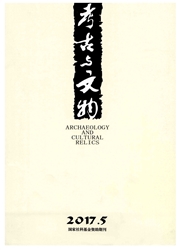

 中文摘要:
中文摘要:
本文通过热电离质谱分析方法对石峁遗址后阳湾地点出土的猪、黄牛和绵羊等动物牙釉质的锶同位素比值进行了测定。研究结果表明,6个猪牙釉质的锶同位素比值的标准偏差小于其他动物,其平均值是0.711185,将该平均值加或减2倍标准偏差得到石峁遗址当地的锶同位素比值范围在0.711303~0.711067之间。根据遗址当地的锶同位素比值范围町以推测在我们所测定的样品中,仅有1只绵羊牙釉质的锶同位素比值在当地锶同位素比值范围以外,据此推测这只羊可能不是在当地出生的:其他黄牛和绵羊牙釉质的锶同位素比值在当地锶同位素比值范围之内,推测它们可能是在遗址当地饲养的。
 英文摘要:
英文摘要:
This article presents results and discusses related issues involved in the employment of strontium isotopic analysis to identify non-local individuals present at the Houyangwan locus of Shimao site. Tooth enamel samples from 25 individuals of domestic mammals, including pigs, sheep and cattle, were analyzed for strontium isotope ratio (87Sr/86Sr) by the thermal ionization mass spectrometry. For the sampling strategy, we sample molars for analysis whenever they are available in the faunal species. As the results demonstrate, the standard deviation of 87Sr/86Sr ratio in enamel samples from domestic pigs was less than half of that of sheep or cattle specimens. This implies that domestic pig bones were better specimens for defining the local 87Sr/86Sr range. The mean 87Sr/86Sr ratios using the six pig teeth enamel samples were 0.711185. According to the local strontium isotopic ratio range determined by the mean 87Sr/86Sr ratios of six pig teeth enamel samples with ±2 sigma s.d. (0.711303-0.711067), the research identifies only one sheep sample from the Shimao site fell well outside the range of local strontium isotopes ratio, indicating it should be considered as a non-local individual. This result also shows that residents at Shimao procured meat resources via different ways.
 同期刊论文项目
同期刊论文项目
 同项目期刊论文
同项目期刊论文
 期刊信息
期刊信息
